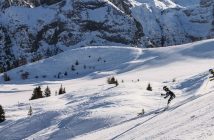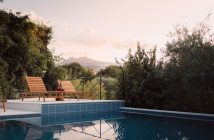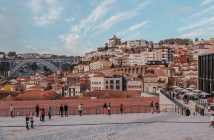There’s nothing like a communal disrobing for making fast friends. I’m in a smoke sauna with an assortment of Europeans at Sahanlahti Resort in Saimaa – Finland’s indecently beautiful lake district near the Russian border – being thwacked with a birch whisk by Sari, my friendly Finnish guide. The walls are black with soot and the heat is so fierce it makes my nose sting. The wooden benches are hot underfoot and I’m given a tiny matt to sit on to prevent my bottom from burning. A few minutes in and I’m already glistening with sweat and imagining the sweet relief of a cooling lake swim.
Finland has been named the world’s happiest country for seven consecutive years by the United Nations and I’m here to find out why. Their sauna culture certainly has something to do with it. Rather than a spa day treat, saunas are a way of life here – in a country of 5.5 million people there are over 3.3m saunas. Finland’s sauna culture was added to Unesco’s cultural heritage list in 2020, but the ritual is believed to date back to 7,000 BC, when pits were dug and filled with heated stones used for warmth during the country’s long, brutal winters.
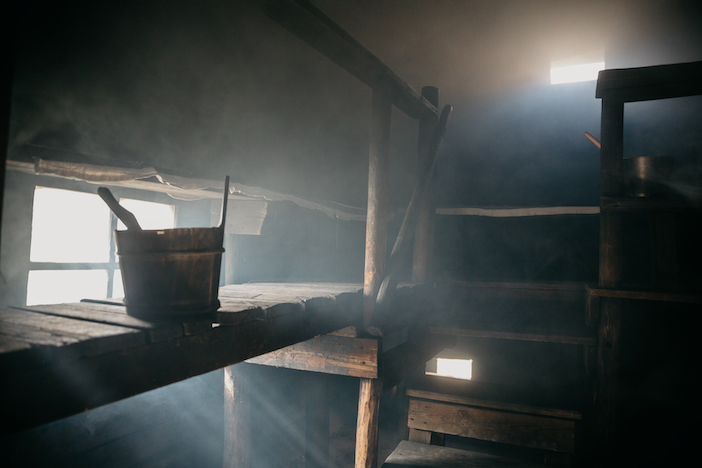
Over time saunas moved above ground and were treated as sacred spaces where women gave birth and the dead were cleansed before burial. Smoke saunas are particularly intense, as they lack a chimney and the oven is fired up eight hours before use, leaving the stones in the hearth fiendishly hot. Largely found outside of cities, smoke saunas are prized for the quality of steam (löyly) they produce when water is cast onto the stones, which, along with the heat, is thought to improve cardiovascular function and reduce inflammation.
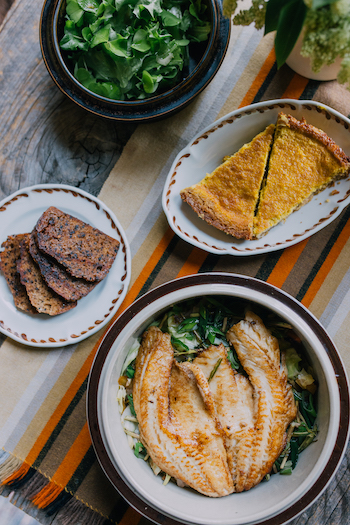 The birch thwacking, meanwhile, is said to help stimulate blood flow and leave your skin feeling soft and supple. The vihta (whisk) had been made for us earlier that day by Asta, an affable nature guide who lives an idyllic, Walden-like existence at Uhkua; a secluded farmhouse in the woods, with her forager and fisherman partner, Ilkka, and their menagerie of ducks, chickens and dogs.
The birch thwacking, meanwhile, is said to help stimulate blood flow and leave your skin feeling soft and supple. The vihta (whisk) had been made for us earlier that day by Asta, an affable nature guide who lives an idyllic, Walden-like existence at Uhkua; a secluded farmhouse in the woods, with her forager and fisherman partner, Ilkka, and their menagerie of ducks, chickens and dogs.
Snow had been on the ground just weeks ago, but we’d arrived during a heatwave. Before the smoke sauna we foraged for sorrel and wild strawberries then feasted like kings on pike caught by Ilkka, duck eggs with nettle béchamel, and an earthy dandelion tart. “The sauna is the poor man’s pharmacy,” Ilkka tells me during our forest walk, recounting how many of his ancestors took their first breaths in one.
Beyond their physical health benefits, saunas serve as spaces for community and connection. Getting your kit off is a great leveller, and the vulnerability involved in bearing your body makes it easier for candid conversation to flow – in Finland a business deal is more likely to be sealed in a sauna than a meeting room. And in our wired world, saunas are one of the few places where you’re forced to disconnect and be fully present in the moment. After 15 minutes of sweating out my toxins in the smoke sauna my head starts to spin, so I step out into the midsummer night and make my way to the lake. Lowering myself in gently, the water feels like death by a thousand cuts and I scream from the shock of it.
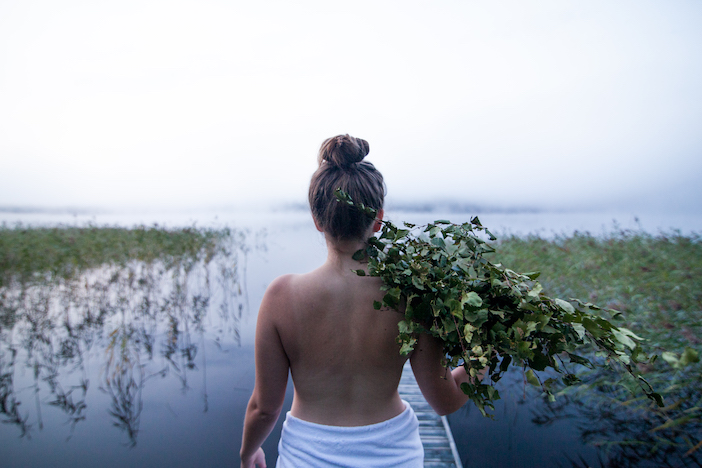
Compared to the searing heat of the sauna the lake feels unbearably cold, but that’s the point – the sudden change in temperature is supposed to boost your immune system, improving circulation and detoxifying the body. Moving my limbs wildly in the water for warmth, my sisu is being put to the test. Encapsulating the resilience of the Finnish spirit, ‘sisu’ roughly translates to ‘perseverance in the face of adversity’, which is needed to get through the harsh winter months. I only manage a minute or two during my first cold plunge, but after a few blasts in the sauna followed by a refreshing lake dip, it’s surprising how quickly your body gets used to the contrast and finds its own rhythm.
Emerging triumphant from my final cold plunge, I feel like an honorary Finn. My skin is pink as a baby and I’m ravenous. Making the most of my newfound calm, I sit swaddled in a bathrobe drinking in the view of the lake, its water perfectly still and reflective as a mirror. The sky is so sublime it looks like it’s been painted. Reclining in a lounge chair, I take greedy gulps from an ice-cold can of Finnish Long Drink – a popular post-sauna tipple created in 1952 for the Olympic Games – while wolfing down a giant slice of rye rammed with smoked salmon, soft boiled eggs and nettle butter. I’m not sure anything has ever tasted so good.

Known for their modesty, the Finns have been reluctant to blow their own trumpet on the food front, and as a result, the Danes have taken most of the credit for the ‘new Nordic’ culinary movement, spearheaded by the likes of Noma and Geranium in Copenhagen, which has swept across the globe. But to bypass Helsinki would be to ignore one of the most exciting food cities in Europe. Proving its culinary mettle, in May Helsinki hosted the Michelin Guide’s glitzy ceremony for the Nordic countries at the Savoy Theatre, where the great and good of the cheffing world gathered to see the stars come out.
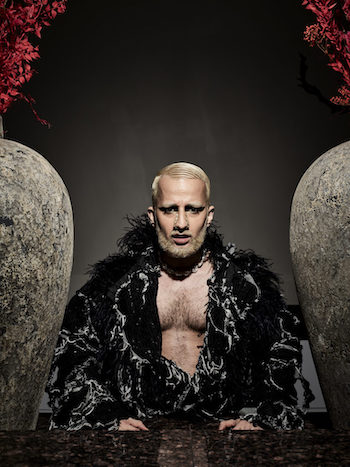 Stealing the show was Iraqi chef Kozeen Shiwan, who picked up a star for his 14-seater restaurant The Room, where the menu takes you on a culinary journey from his early years in Suleymaniah and Turkey to his escape to Finland in 1998 as a political refugee. A consummate showman with a bleached blond buzz cut, glinting row of gold teeth, numerous piercings and eyes heavy with kohl, he looks dressed for the Met Gala in baggy leather trousers, huge black boots and a jacket adorned with black feathers. When his Michelin star is announced he leaps onto the stage and struts around like a peacock, staring down the barrel of the flashing cameras, swearing like a trooper and lapping up every delicious second of it.
Stealing the show was Iraqi chef Kozeen Shiwan, who picked up a star for his 14-seater restaurant The Room, where the menu takes you on a culinary journey from his early years in Suleymaniah and Turkey to his escape to Finland in 1998 as a political refugee. A consummate showman with a bleached blond buzz cut, glinting row of gold teeth, numerous piercings and eyes heavy with kohl, he looks dressed for the Met Gala in baggy leather trousers, huge black boots and a jacket adorned with black feathers. When his Michelin star is announced he leaps onto the stage and struts around like a peacock, staring down the barrel of the flashing cameras, swearing like a trooper and lapping up every delicious second of it.
Tapio – a tiny casual dining restaurant run by British chef Connor Laybourne in the Finnish ski resort of Ruka – also receives a star, taking Finland’s total to nine, with the tasting menu-led Palace in Helsinki retaining its two stars. Leading by example, harbourside venue Nokka picks up a Green star and is praised for its zero-waste approach that sees leftover wine used to make vinegar and cooking oil sent to veg suppliers to heat their greenhouses. Hitting the after party hard, my head is still swirling with Champagne the next morning, so I head for an early sauna at the Grand Hansa – the latest addition to Helsinki’s five-star hotel scene – in an attempt to blow away the cobwebs.
Lunch at Restaurant 305 in Helsinki’s Hakaniemi neighbourhood provides a glimpse into the casual dining movement that’s gripping the city. The fun and unpretentious venue picked up a Bib Gourmand at the Michelin ceremony, so heads are sore but spirits are high among the staff. “It feels like a surreal dream – I hope I don’t wake up,” the bleary-eyed sommelier tells me as he pours a generous glass of Crémant de Jura to kick off the meal. I’m hoping hair of the dog works.
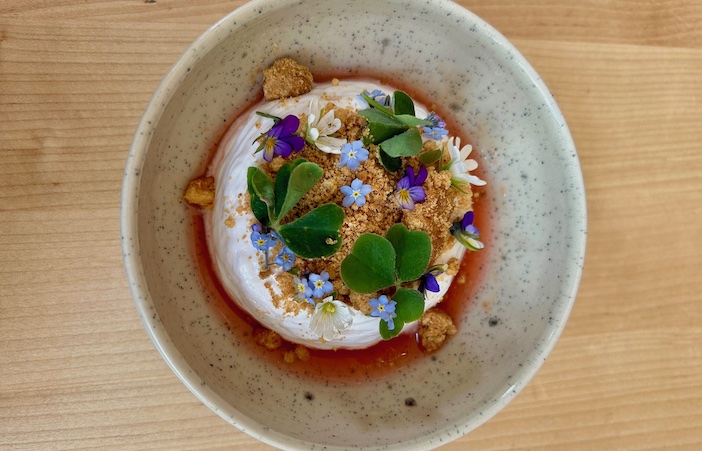
The walls are bottle green, the bar stools lipstick pink, the crockery mismatched and the kitchen open. Old Marlene Dietrich film posters share wall space with Ninja Turtle artworks and Talking Heads record covers. Proving the perfect hangover food, we’re served a giant gnarly hunk of buttermilk fried chicken accompanied by a simple but blissful gem salad slathered in ramson mayo. The combination of the moreish chicken with the cooling salad is one of the most delicious and joyful dishes I’ve eaten all year.
Another quirky Helsinki hotspot worth seeking out is the Luovuus Kukkii Kaaoksesta (Creativity Blooms From Chaos), run by ebullient restaurateur and antiques fanatic Samu Räsänen. Walking into the restaurant feels like stepping inside his brain. In it you’ll find old black-and-white movies playing on a vintage orange TV; a poster of Kubrick’s 2001: A Space Odyssey; a mural featuring floating chanterelles, crabs and carrots; and a stuffed badger sitting atop an old radio.
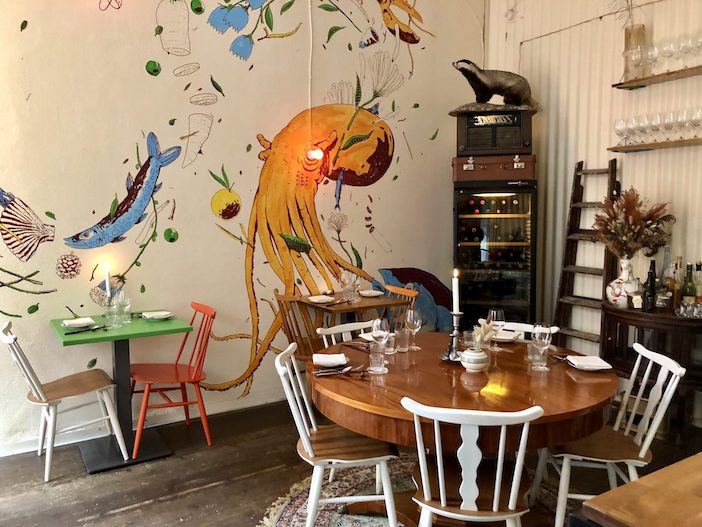
The chaotic décor leaves me wondering how creativity might bloom there, but my doubts are quickly assuaged with the arrival of the bread and butter – tangy homemade sourdough with a smear of squid ink and kombu butter that looks like cement but is light as air and tastes heavenly. Like so many chefs, Räsänen takes inspiration from Japan in his confidently clipped menu, which begins with yellowtail sashimi swimming in ponzu and then puts veg like the humble swede and much maligned white asparagus on a pedestal, elevating them with exquisite sauces and thoughtful wine pairings from the Loire, Burgundy and beyond.
Over lunch with Heidi Johansson of Helsinki Partners, I drill deep into the Finnish psyche, keen to find out why Finland continually tops the UN’s annual World Happiness Report. “It all comes down to how you define happiness,” she says. “Dreams have a different shape here – people aren’t so motivated by money. Finland is a very non-judgemental country where people are free to be themselves, and there’s a lot of trust here, both in institutions and in each other. Finnish happiness isn’t about smiling in the street; it’s an inner state of being.”
Return flights from London Heathrow to Helsinki with Finnair start at £168. Information on where to go and what to do during your stay can be found at www.visitfinland.com.


